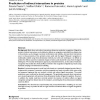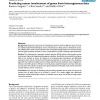131 search results - page 17 / 27 » Sequence Prediction Based on Monotone Complexity |
BMCBI
2008
13 years 10 months ago
2008
Background: The heterokonts are a particularly interesting group of eukaryotic organisms; they include many key species of planktonic and coastal algae and several important patho...
BMCBI
2006
13 years 10 months ago
2006
Background: Both direct and indirect interactions determine molecular recognition of ligands by proteins. Indirect interactions can be defined as effects on recognition controlled...
BMCBI
2008
13 years 10 months ago
2008
Background: Mass spectrometry is a key technique in proteomics and can be used to analyze complex samples quickly. One key problem with the mass spectrometric analysis of peptides...
BMCBI
2008
13 years 10 months ago
2008
Background: Systematic approaches for identifying proteins involved in different types of cancer are needed. Experimental techniques such as microarrays are being used to characte...
BMCBI
2007
13 years 10 months ago
2007
Background: Large-scale sequencing of entire genomes has ushered in a new age in biology. One of the next grand challenges is to dissect the cellular networks consisting of many i...


